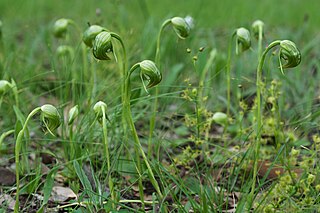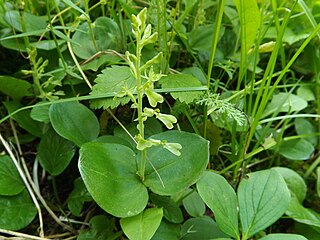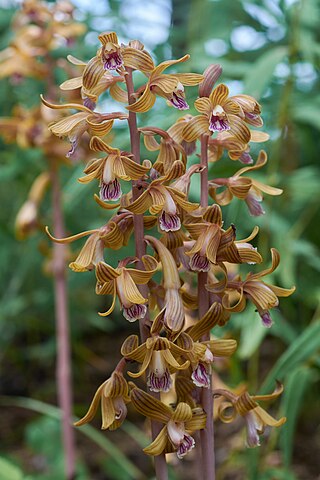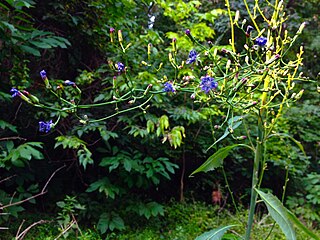
Arethusa bulbosa, commonly called dragon's mouth orchid, is the only species in the orchid genus Arethusa. The genus is named after a naiad of Greek mythology. This monotypic genus is abbreviated Aret in trade journals.

Calopogon tuberosus, the tuberous grass pink, is an orchid native to eastern North America.

Sambucus racemosa is a species of elderberry known by the common names red elderberry and red-berried elder.

Pterostylis nutans, commonly known as the nodding greenhood or the parrot's beak orchid, is a species of orchid endemic to eastern Australia. Nodding greenhoods have flowers which "nod" or lean forwards strongly, have a deeply notched sinus and a curved, hairy labellum.

Goodyera pubescens, the downy rattlesnake plantain, is one of the most common orchids native to eastern North America. It is found from Florida to Nova Scotia, west to eastern Oklahoma, Minnesota and Ontario.

Oncidium ensatum, the Latin American orchid or Florida dancinglady orchid, is a species of orchid found in southern Florida, southern Mexico, Central America, Cuba, the Bahamas, and northwestern Venezuela.

Neottia convallarioides is a species of orchid known by the common names broad-lipped twayblade and broad-leaved twayblade. It was formerly placed in the genus Listera, but molecular phylogenetic studies have shown that Neottia nidus-avis, the bird's-nest orchid, evolved within the same group, and all species of Listera have been moved to Neottia.

Triphora is a genus of flowering plants from the orchid family, Orchidaceae. It is native to South America, Central America, southern Mexico, the West Indies and eastern North America as far north as Ontario. Noddingcaps is a common name for plants in this genus.
- Triphora amazonicaSchltr. - Florida, Caribbean, south to Brazil
- Triphora carnosula(Rchb.f.) Schltr. - Brazil
- Triphora craigheadiiLuer - Florida
- Triphora debilis(Schltr.) Schltr. - southern Mexico, Costa Rica, Guatemala, Panama
- Triphora duckeiSchltr. - Brazil
- Triphora foldatsiiCarnevali - Venezuela
- Triphora gentianoides(Sw.) Nutt. ex Ames & Schltr. - Florida, Southern Mexico, Costa Rica, Veenzuela, Colombia, Ecuador, Bahamas, Greater Antilles
- Triphora hassleriana(Cogn. ex Chodat & Hassl.) Schltr. - from Mexico to Argentina
- Triphora heringeriPabst - Brazil
- Triphora miserrima(Cogn.) Acuña - Cuba, Hispaniola
- Triphora nitida(Schltr.) Schltr. - Costa Rica
- Triphora pusilla(Rchb.f. & Warm.) Schltr. - Brazil
- Triphora ravenii(L.O.Williams) Garay - Costa Rica, Panama
- Triphora santamariensisPortalet - Brazil
- Triphora surinamensis(Lindl. ex Benth.) Britton - West Indies south to Brazil
- Triphora trianthophoros(Sw.) Rydb. Ontario, Eastern United States, much of Mexico
- Triphora unifloraA.W.C.Ferreira, Baptista & Pansarin - Brazil
- Triphora wagneriSchltr. - from Mexico to Ecuador
- Triphora yucatanensisAmes - Florida and the Yucatán Peninsula

Neottia bifolia, common name southern twayblade, is a species of terrestrial orchid found in eastern Canada and the eastern United States.

Cleistesiopsis is an orchid genus in the tribe Pogonieae. Its members were included in Cleistes until 2009. Cleistesiopsis is native to the eastern and southeastern United States from New Jersey south to Florida, and west to Kentucky and Louisiana. The common names are rosebud orchid and small spreading pogonia.

Isotria verticillata, commonly known as the large whorled pogonia and purple fiveleaf orchid, is an orchid species native to eastern North America.
Malaxis bayardii, or Bayard's adder's-mouth orchid, is a species of orchid native to northeastern North America. It is found from Massachusetts to North Carolina, with isolated populations in Ohio and Nova Scotia. There are historical reports of the plant formerly growing in Vermont and New Jersey, but it seems to have been extirpated in those two states It grows in dry, open woods and pine barrens at elevations of less than 600 m.

Cleistesiopsis divaricata, the rosebud orchid or small spreading pogonia, is a terrestrial species of orchid native to the eastern United States from New Jersey to Florida.
Basiphyllaea corallicola is a species of orchid native to Florida, Bahamas, Cuba, Hispaniola, and Puerto Rico.
Cleistesiopsis oricamporum, called the small Coastal Plain spreading pogonia, is a terrestrial species of orchid native to the southeastern United States from Louisiana to North Carolina.

Cleistesiopsis bifaria, the smaller spreading pogonia, is a terrestrial species of orchid native to the eastern United States, along the Appalachian Mountains from West Virginia to Alabama.

Hexalectris spicata, the spiked crested coralroot, is a terrestrial, myco-heterotrophic orchid lacking chlorophyll and subsisting entirely on nutrients obtained from mycorrhizal fungi in the soil. It is native to Arizona, New Mexico, Texas and Coahuila. It is closely related to H. arizonica and the two are sometimes considered varieties of the same species. Hexalectris spicata is endemic to the southern half of the United States from Arizona east to Florida and north to Maryland and the Ohio Valley.

Lactuca floridana, commonly known as woodland lettuce, Florida lettuce, or false lettuce is a North American species of wild lettuce. It is native across much of central Canada and the eastern and central United States.

Spiranthes ovalis, commonly called the October lady's tresses, is a species of orchid that is native to eastern North America.

Platanthera pallida, commonly known as pale fringed orchid, is a rare orchid of North America with the only known occurrences on Long Island.


















